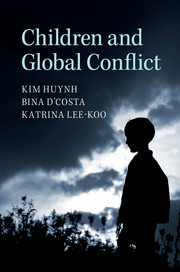Book contents
- Frontmatter
- Dedication
- Contents
- List of abbreviations
- Introduction: why children matter to global conflict
- 1 Children and armed conflict: mapping the terrain
- 2 Children and agency: caretakers, free-rangers and everyday life
- 3 Children and IR: creating spaces for children
- 4 The rights of the child: political history, practices and protection
- 5 Child soldiers: causes, solutions and cultures
- 6 Child forced migrants: bio-politics, autonomy and ambivalence
- 7 Children and peace building: propagating peace
- 8 Children and justice: past crimes, healing and the future
- 9 Who speaks for children? Advocacy, activism and resistance
- Conclusion
- Appendix
- Bibliography
- Index
5 - Child soldiers: causes, solutions and cultures
Published online by Cambridge University Press: 05 May 2015
- Frontmatter
- Dedication
- Contents
- List of abbreviations
- Introduction: why children matter to global conflict
- 1 Children and armed conflict: mapping the terrain
- 2 Children and agency: caretakers, free-rangers and everyday life
- 3 Children and IR: creating spaces for children
- 4 The rights of the child: political history, practices and protection
- 5 Child soldiers: causes, solutions and cultures
- 6 Child forced migrants: bio-politics, autonomy and ambivalence
- 7 Children and peace building: propagating peace
- 8 Children and justice: past crimes, healing and the future
- 9 Who speaks for children? Advocacy, activism and resistance
- Conclusion
- Appendix
- Bibliography
- Index
Summary
Introduction
We will fight until the last drop of blood!
This is what my father and uncle wrote on the wall of the family ancestral shrine, using blood that trickled from their freshly cut fingertips. Shortly afterwards, they left their village to become Viet Minh revolutionaries. At the age of twelve, my father was convinced that this was the best way for him to break free of poverty and attain an education. At the same time, he was eager to rescue his country from colonial oppression and was willing to sacrifice his life if need be.
This chapter examines some of the international, national, local and personal factors that motivate children to engage in war. Caretaker (or liberal humanitarian) and free-ranger (or critical childhood studies) perspectives are adopted to analyse the child soldier problem. From a caretaker position, no one is more vulnerable than a child and nothing is more senseless and destructive than war; therefore, the coalescence of the two in the form of a child soldier represents an injustice of the highest order. This perspective, which is prominent in international legal and advocacy circles, promotes a broad definition of child soldiers in terms of both age and activity and seeks to protect these victims of circumstance regardless of what they have done. When it comes to providing that protection, caretakers also take a global view in that ‘everyone shares responsibility and a degree of blame’. The free-ranger position, on the other hand, asserts that the caretaker understanding of the child soldier problem does not so much reflect the lawlessness and insecurities of the global south, but rather a deep-set anxiety and desire for control in the global north. While the differences between these two camps are considerable, there is room for agreement in terms of how to address the child soldier problem. Specifically, indirect efforts that focus on socio-economic development, peace making and peace building can result in children and adults having less incentive to fight and can be more effective than direct efforts to save child soldiers which carry a high risk of cultural imperialism.
- Type
- Chapter
- Information
- Children and Global Conflict , pp. 123 - 158Publisher: Cambridge University PressPrint publication year: 2015



